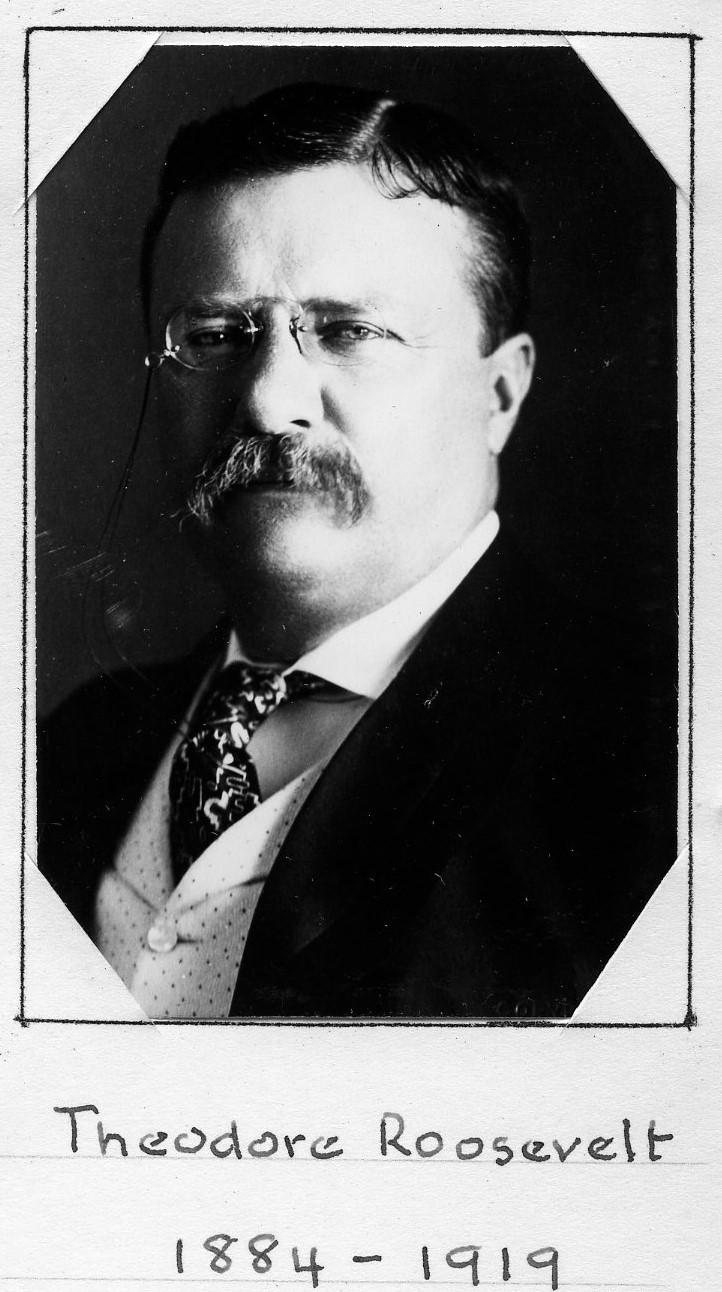Lawyer/Governor of New York/U.S. President
Centurion, 1884–1919
Born 27 October 1858 in New York (Manhattan), New York
Died 6 January 1919 in Oyster Bay, New York
Buried Youngs Memorial Cemetery , Oyster Bay, New York
, Oyster Bay, New York
Proposed by Mr. Mitchell (may refer to Edward Mitchell or John Ames Mitchell) and Mr. Tuckerman (may refer to Gustavus Tuckerman, Lucius Tuckerman, or Walter C. Tuckerman)
Elected 5 April 1884 at age twenty-five
Archivist’s Note: Son of Theodore Roosevelt; nephew of Cornelius Van Schaick Roosevelt, James A. Roosevelt, Robert Barnwell Roosevelt, and Silas Weir Roosevelt; cousin of Alfred Roosevelt and James West Roosevelt; uncle-in-law of Franklin D. Roosevelt; grandfather of J. Willard Roosevelt.
Proposer of:
Century Memorials
It was only with the dawning of the New Year that the Century was called upon to record the loss to its membership of that remarkable personality in American public and private life, Theodore Roosevelt. Chosen to the Century Club in 1884—the very year in which, at the age of twenty-six, he first tried his strength at influencing the country’s political destinies through a presidential nominating convention—his term of membership had been outrun by less than twoscore of the much older remaining members of the Club. The review of the career of this extraordinary man will be the work of other hands; the Century’s tribute to him the task of another and a special occasion. But the sense of being somehow linked with the great events of history comes intimately home to all of his fellow members at a time when his own life, and the great war in which his whole mind was absorbed, terminated within a few weeks of one another.
Alexander Dana Noyes
1919 Century Association Yearbook
Roosevelt was born in New York City, the son of the wealthy Theodore Roosevelt, Sr. and Mittie Bulloch. His father, whom he adored, died in his 40s, just six years before Teddy joined the Century. Young Teddy (a nickname he detested) struggled against poor health, and in his triumph became an advocate of the strenuous life.
In 1884, his first wife, Alice Lee Roosevelt, and his mother died on the same day, and he spent much of the next two years on his ranch in the Dakota Territory. In 1885, he built Sagamore Hill in Oyster Bay, which would become his home and estate until his death. In 1886, Roosevelt ran for Mayor of New York as “The Cowboy of the Dakotas,” but he lost to Democrat Smith Ely, Jr. On a visit to London that same year, he married Edith Carow, and they had five children: Teddy had a daughter Alice by his first wife.
During the Spanish-American War, Roosevelt was a lieutenant colonel in the Rough Riders Regiment, which he led on a successful charge at the Battle of San Juan. He was one of the most conspicuous heroes of the war, which propelled him into the Governor’s chair in 1898. He became the vice-presidential running mate of William McKinley in 1900. In 1901, as Vice-President, the 42-year-old Roosevelt became President following McKinley’s assassination. In the 1904 presidential election, Roosevelt won the presidency in his own right in a landslide victory over Democrat Alton B. Parker.
Roosevelt ensured the construction of the Panama Canal, and was a leading conservationist, adding enormously to the national forests of the West. He was the first president to call for universal health care and national health insurance. Roosevelt received the Nobel Peace Prize in 1906 for mediating the end of the Russo-Japanese War, the first American to win the prize.
Roosevelt chose not to run in 1908 and backed his Secretary of War William Howard Taft. In 1911, he broke with Taft, but lost the GOP nomination to him and ran on his own one-time Bull Moose ticket in 1912. He beat Taft in the popular vote, but Woodrow Wilson won the election.
Roosevelt was considering a third presidential campaign in 1920 until he was laid low by illness. On January 6, 1919, he died in his sleep at Oyster Bay.
James Charlton
“Centurions on Stamps,” Part I (Exhibition, 2010)

